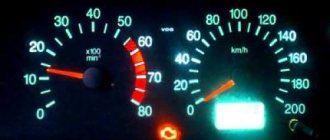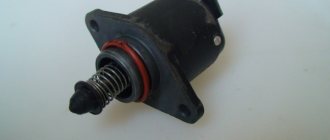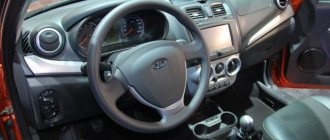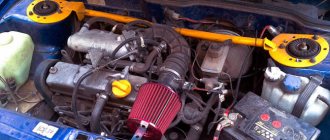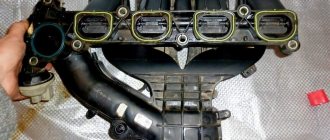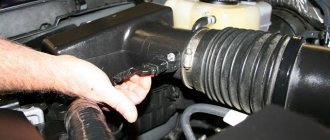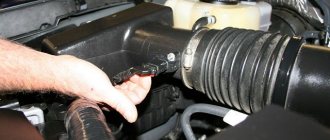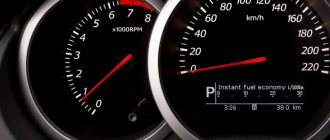Floating speeds should be distinguished from interruptions in operation associated with impaired combustion of the air-fuel mixture in one or more cylinders. In our case, the engine runs smoothly, but the tachometer needle twitches. Let's look at why the idle speed fluctuates and what the driver should do to independently determine the cause of the malfunction.
Suction of unaccounted air
Most often, jumps in engine speed at idle are associated with the suction of unaccounted air into the intake manifold. The engine control unit regulates the opening time of the injectors, relying on the readings of the mass flow sensor (MAF) or absolute pressure sensor (ABP) paired with an air temperature sensor (ATS). The ECU (Engine Control Module) fuel maps contain the desired idle speed, which is maintained using the idle speed controller (IAC) or an electrically driven throttle valve.
In an injection power system with a flow meter, any leakage in the intake tract after the mass air flow sensor will cause unstable engine speed at idle. The actual amount of air entering the cylinders will be greater than the calculated values, which are based on the MAF readings. Also, a lean mixture error often occurs, since the ECU registers unaccounted air only after the fact, based on the readings of the oxygen sensor (lambda probe).
As more air enters the engine, the speed rises, causing a mismatch in the ECU between the desired crankshaft speed and the actual crankshaft speed. Wanting to equalize these values, the controller closes/opens the idle air control or throttle valve, if the IAC is not provided structurally. But due to unaccounted air, it is impossible to set the speed; they begin to rise and fall, which the driver notices by the twitching tachometer needle.
Approaches to solving the problem
When all the causes have been identified, you can proceed to troubleshooting. Of course, there are a different number of ways to solve the problem, but do not forget that a certain sequence of actions is necessary. It is worth considering the issue in more detail.
Adjust fuel level and idle speed
Adjusting the idle speed on Ozone carburetors. You will need a tachometer and a slotted screwdriver. Work must be carried out on a warm engine. By turning the “quantity” screw in the clockwise direction, you can achieve an increase in speed.
If it is not possible to solve this problem with one “quantity” screw, you need to connect a “quality” screw, which, if it has not been used yet, may have a factory plug on it. It can be pulled out by screwing a suitable screw into the plastic and pulling it out.
Adjustment is usually carried out in 2-3 (several) passes.
Replace spark plugs
Even if the spark plugs have recently been replaced, they may be of poor quality or defective. Original spare parts are always better than cheaper analogues. A falling XX often hints at this malfunction.
Change fuel
Using sensors, it is necessary to check the pressure in the fuel supply system and the presence of contaminants. After which you need to change the fuel to a cleaner and higher quality one. As a last resort, you should consider refueling at a gas station of another company.
Check air and fuel filters
The air filter may be dirty. As the filter becomes dirty, the amount of air entering the engine decreases. Engine power decreases and fuel consumption increases significantly.
The air filter needs to be cleaned or, more importantly, replaced. It is best to carry out this procedure in advance to avoid other problems in the future.
Clean the idle speed sensor
If oil and other contaminants enter the sensor, it will fail. The sensor is cleaned with carburetor cleaner and aerosol liquid. The device must be removed and washed. The aerosol liquid gently cleans the needle. Be careful that liquid does not get into the inside (that is, under the spring), to avoid its failure.
ECU "saws" idle speed
In case of significant leakage of the intake tract in a system with DBP + DTV, a situation arises when the engine spontaneously spins up to 1500-2500 rpm, after which the speed drops sharply by 700-900/min. Since the nature of the jumps on the graph has a sawtooth shape, it is often said in this case that the controller is “sawing” the idle speed.
This phenomenon becomes possible due to an increase in pressure in the intake manifold (the reason is suction) when the throttle valve (DZ) is closed. The ECU monitors the throttle position using a special sensor mounted in the throttle body. In normal mode, a situation in which more air enters the engine and the throttle valve is completely closed is only possible when the engine is braking. For example, when, when driving down a hill in gear, the driver completely releases the accelerator pedal. The crankshaft revolutions will increase due to the inertia of the car picking up speed on a descent. To reduce fuel consumption, it is logical to turn off the fuel supply, which the ECU does until the speed drops slightly above idle. In other words, sawtooth fluctuations in idle speed occur due to a false determination by the ECU of the engine braking mode.
Low pressure in the fuel rail.
Another reason when there is no idle, or poor idle and the car jerks and drives poorly is insufficient pressure in the fuel rail. The pressure must be measured using a pressure gauge, cutting into the fuel line where the fuel rail and the line from the fuel pump meet.
What pressure should be in the fuel rail? Here it is already necessary to look at the manual for this car, since in many cars the pressure in the fuel rail is different.
I have met many craftsmen who repair cars at random, that is, by replacing everything in a row, by elimination. But you just need a correct and logical approach, and it wouldn’t hurt to understand how injection engines work. Agree - it’s easier and cheaper to measure the pressure in the fuel rail than to immediately change the fuel pump. I think it won’t be difficult to find a guide on exactly what pressure should be in your car. It is very easy to measure the pressure and rule out or judge the fuel pump to be faulty. So before spending money on buying new parts, always properly diagnose a particular part first.
Common places for air leaks
- Loose clamps on pipes and vacuum hoses.
- Cracks in rubber hoses and pipes. Most often found near clamps, in places of contact with elements of attachments.
- Broken brake booster diaphragm.
- Leaking vacuum valves (PCV, EGR, absorber purge valve). The cause of the leak is a leaky membrane, but cracks in the housing should not be ruled out. If your car is equipped with HBO, check the vacuum corrector.
On Japanese-made cars, when troubleshooting, pay attention to the system of vacuum valves involved in adjusting the warm-up speed and opening the additional air channels.
- A crack in the plastic intake manifold due to a manufacturing defect or mechanical damage. Often such collectors consist of several elements assembled on sealing gaskets. If the gaskets become tanned due to temperature loads in the compressed state, air will be sucked into the intake manifold through them.
- Loose fit of the intake manifold to the cylinder head.
- Worn or incorrectly installed fuel injector O-rings.
- Wear of the throttle valve rotation axis in the housing (very common on Mitsubishi Lancer 9).
Is it possible to independently find the cause of floating speed?
As the experience of practicing diagnosticians shows, the speed begins to float after maintenance or other repair work in the engine compartment. Often, during the work process, craftsmen forget to connect or, unbeknownst to themselves, pull the vacuum hoses from the fittings. Therefore, if the car has recently been repaired, inspect the engine compartment for broken fittings and unconnected vacuum tubes. If a visual inspection turns up nothing, use a few simple methods to find air leaks.
- Using pliers, pinch the rubber hoses and pipes that fit into the manifold one by one. This way you turn off the system and eliminate its influence on engine operation.
- Spray water on the intake manifold and vacuum pipes. When water is sucked into the intake tract along with unaccounted air, you will hear a characteristic sound. Often the leak can be identified by hissing when the engine is idling.
- Build a smoke generator from available materials (there are a lot of instructions on the Internet for assembling such a device at home). The essence of the test is to fill the intake tract with smoke. In areas of leakage, smoke will escape. The test is best carried out in a room with the lights turned off, using a flashlight to highlight possible leak points. Before searching for the cause of floating speed, it is necessary to tightly plug the corrugation suitable for the air filter.
EGR system
This system is designed to return some of the exhaust gases back into the cylinders to improve ignition in the combustion chambers. On a warm engine, its malfunction can lead to sudden jumps in idle speed. The main purpose of EGR is to reduce toxic emissions into the atmosphere. Due to constant exposure to elevated temperatures, the EGR valve becomes clogged, which leads to floating crankshaft speeds. Fix the breakdown by simply cleaning the seat on the valve; if this does not help, then it needs to be replaced.
How does IAC affect idle speed?
The speed may fluctuate if the idle speed control is not working properly. IAC is a key element in stabilizing idle speed. It is necessary to adjust the flow area of the bypass channel connecting the intake tract to the throttle and the after-throttle space at the moment when the throttle body is completely closed. With the help of IAC, the engine control unit increases the amount of air entering the intake manifold as the engine load increases during idle speed. We are talking about turning on powerful electrical consumers (heater fan, headlights, windshield wipers, heated glass, etc.).
The operating principle of the regulator is based on the movement of a rod that blocks the bypass channel. In a de-energized state, the valve closes the channel under the action of a return spring. When power is applied, the stepper motor (the number of steps is regulated by the duty cycle of the signal) retracts the rod to the required distance, thereby changing the flow area of the channel. Signs of a malfunctioning idle air control:
- engine speed fluctuates;
- the engine stalls while driving when the gear is switched off;
- the engine is unstable and may stall when the air conditioner or powerful electrical consumers are turned on;
- no warm-up speed (1100-1300 rpm);
- When you release the gas sharply, the speed slowly drops and freezes.
Possible faults
- Contamination of the channel, rod, appearance of rust on the rod. The valve travel is difficult, so the ECU cannot accurately regulate the cross-section of the bypass channel.
- Motor malfunction. Often the cause of failure is depressurization of the IAC housing, which allows dust and moisture to get inside.
- Breakage of power wires, appearance of oxides on connector contacts, weak contact in connecting blocks.
The regulator control circuit inside the ECU is extremely reliable and fails if moisture gets inside the unit, the supply wires are shorted, or if the tracks or elements of the printed circuit board are mechanically damaged.
Conclusion
A drop in engine speed is a fairly common problem. It can happen not only for any one reason - when the engine is severely worn out, an integrated approach is required, and the breakdowns can be quite specific. In this case, you may need to seek professional help.
When purchasing a car, few people think about the need for timely maintenance. Failure to do this leads to periodic breakdowns of its various mechanisms and power unit.
One of the most common malfunctions associated with improper maintenance is improper operation of a warm engine idling.
This article will help you figure out why this happens.
Throttle valve malfunctions
Most modern injection power systems do not have IAC. Its role is played by the electric throttle valve. Using an electric motor, the ECU opens the throttle valve to the required angle, regulating the amount of air consumed by the engine at idle. Unlike the governor, which has no feedback, the ECU monitors the throttle position using 2 position sensors at once.
The symptoms of a faulty throttle valve are similar to the symptoms of a broken/contaminated IAC. Most often, eliminating speed surges and floating speed at idle is limited to flushing the throttle valve. To do this, you need to remove the throttle assembly and wash it well with gasoline and a soft lint brush.
It is strictly forbidden to clean the inside of the throttle with metal brushes or sharp objects. It is best to use special carburetor cleaners in aerosol cans for flushing.
If cleaning does not solve the problem of floating idle speed, start with computer diagnostics. It is likely that reading trouble codes and identifying anomalies in the position sensors will point you in the right direction to find the cause of unstable idle speed. Often, after flushing, the throttle, like the IAC, needs to be adapted using diagnostic equipment.
Video: Is the idle speed floating? Useful tips
EGR system
This system is designed to return some of the exhaust gases back into the cylinders to improve ignition in the combustion chambers. On a warm engine, its malfunction can lead to sudden jumps in idle speed. The main purpose of EGR is to reduce toxic emissions into the atmosphere. Due to constant exposure to elevated temperatures, the EGR valve becomes clogged, which leads to floating crankshaft speeds. Fix the breakdown by simply cleaning the seat on the valve; if this does not help, then it needs to be replaced.
